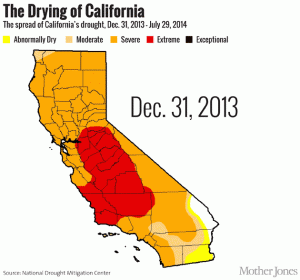Golden or Grueling?
The severe drought in California has been draining the energy and resources of the “Golden” State. As each day passes, a constant state of dry and parched land plagues the landscapes of this western area. Entering into a fourth year of record-breaking drought, worries still persist as the soil becomes exceedingly dry; fires caused by harsh conditions become unmanageable and destructive; restrictions on water continue to climb with concerns on the effects of its management. These problems obviously impact California, but can they also have an adverse effect on other areas, like our own home state of Colorado?
Factors influencing the severity of the drought primarily center around the increased heat of recent years. With record highs since the 1800s in California, the hotter temperatures of today have exacerbated the water cycle to its breaking point. Heat does not allow for as much snow-pack to be stored on the slopes of mountains, which leads to a reduction in the amount of public water that exists for California. The snow-pack percentage in this state is now 5% of its normal level; this means that it is lower than it has ever been before, and it also means that the drought could continue indefinitely as climate change grows. Additionally, higher heat means higher rates of water evaporation, yet also a higher need for water from vegetation. Thus, a dual issue exists as conditions of the drought worsen.
So what does this mean for us? Essentially, we must keep in mind that as the issue of climate change grows in importance, there is a possibility that Colorado could eventually be affected in just the same way. Consciousness of current issues, and ways to prevent higher temperatures from increasing are key to the prevention of drought in other states, including ours. As informed citizens and members of our country, steps to eliminate climate change will be vital to the future of water availability and land conditions for all. In addition, while much of Colorado water is sourced from the state’s own mountains, a decrease in snowmelt for California could still have indirect effects. Perhaps our supply will be accessed more heavily by these far western areas as their own resources become depleted and the need for water expands exponentially. Or, conversely, there may be a draw to move inward, with a “migration” of former California residents to more inland states, like Colorado.
Soil has very literally been “soiled” across the state as a lack of moisture propels the drought forward. In the central and southern part of California, with the use of the Palmer Drought Severity Index (PDSI), it has been determined that the degree of soil moisture is currently at the “lowest level for any three year period on record” (Griffin). This means that the entire period of drought so far has not been interrupted or revived by any years of rainfall. This is different from past years because usually periods of drought are ended by or broken up by years of normal rainfall. Different kinds of droughts have existed overtime, but it has been a while since one so lengthy and continuous has persisted.

Photo via Wikimedia Commons under the Creative Commons license.
https://commons.wikimedia.org/wiki/File:View_from_Marine_One_on_California_Drought.jpg
Therefore, with soil dryness, and about 31.5 million acres of the state dedicated to growing and harvesting crops, agricultural production has struggled. The fact that water requirements for plants have been driven up higher than any in previous years has only added to the challenges that the drought has created. On a broader scale, because California works as a main provider of produce across the country, this will have a direct impact on states like Colorado, who rely on certain goods so that customer needs are satisfied. As a result, the chance of fewer crops will reduce the amount of goods sourced from California overall. This may eliminate the availability of some common fruits and vegetables in our state, which will either cause prices to increase or a need for new sources to be found.
Due to the drought, the number of fires that have occurred in California are at an all time high. The lack of moisture in underbrush and thick trees has caused many areas of the state to be subject to greater chances of fire, since there is no longer a correct amount of dampness in the environment (which would usually create some fire resistance). Firefighters in the area of the Sierra Nevada have struggled to contain and manage “some of the biggest wildfires they’ve ever seen.” These fires have been destructive to not only the environment, but also the wildlife in these areas. As a result, many native species have become newly extinct as destructed areas and dry streambeds develop easily due to the damage caused by these fires.
In order to improve conditions, rules regarding water usage and regulation have been established. Very little water allows for very few options in water distribution and an increased restriction of water per citizen. The governor of California, Jerry Brown, has set some of these regulations, and as they continue to develop, the demand for water is always somehow reduced so that the effects of the drought can be minimized. In addition, widespread emergency declarations have encouraged communities to use the resources available to them in order to overcome the low levels in supply of water. Some restrictions are in fact stifling, and they don’t always sit well with cities and citizens involved. Consequently, the various sides of conflict that occur will be one problem of many in determining the future of those affected.
A rising population makes for a growing challenge, as more needs for water grow along with it. At a population of 38 million, the number of citizens has increased considerably since the 1930s. Thus, this situation has been a “supply drought and a demand drought,” according to Peter Gleck, since there is a low amount of water, but a high need for it. The issues caused by restrictions are sure to encourage a potential if not temporary migration from state to state by citizens. A large population, therefore, is another factor that could cause migration to Colorado, due to the fact that many large cities have been struggling to adjust to the new restrictions, and their citizens are often upset by them. This is logical because, at a base line, water is our most important resource, and when access to any vital resource is reduced, the people will suffer because of it.

Photo via Wikimedia Commons under the Creative Commons license.
https://commons.wikimedia.org/wiki/File:Progression_of_the_2012-2014_historic_California_drought,_from_December_2013_to_July_2014.gif
So what does all this mean for the future? Well, it is in fact a possibility that the West could face even drier and longer periods of heat as climate change occurs, even Colorado, that is. Just as all states in the U.S., but also all countries in the world have to work with and understand how to use their resources, so does California. There will have to be a serious reduction in how much water people will and can use, and perhaps also a change in mentality as the impact of what has been called the “worst drought on record” (Gleick) truly rises to the surface. As the drought continues, a greater rate of management in resources and consciousness of the conditions must be considered more seriously, with a focus on ways to constantly improve this issue that is not going away any time soon. As Coloradans, we can only hope for effects of the drought to be minimized, but at the same time we must also keep mindful watch over our own behaviors and practices regarding resources to ensure appropriate water use and availability for the future.
Citations:
Dalrymple, Jim. “How Severe Is California’s Drought.” BuzzFeedNews. Buzz Feed, n.d. Web. 5 Oct. 2015.
Associated Press. “California Drought: Study Sees Dying Wildlife, Bigger Fires.” NBC News. N.p., n.d. Web. 06 Oct. 2015.
Maslin, Sarah. “California Fire, Aided by Drought, Defies Tactics to Defeat It.” The New York Times. N.p., 5 Aug. 2015. Web. 06 Oct. 2015.

Hi, I'm Emily! I am a senior who enjoys writing, reading, watching Netflix, listening to music, and hanging out with friends. I also enjoy singing, playing...













